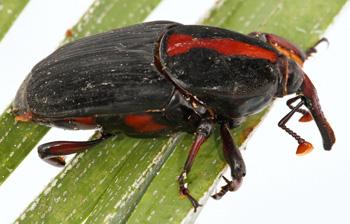Fall 2011: Getting Serious About Palm Weevils
Regional Report San Diego and Riverside Counties by James A. Bethke
Back in May 2010, I was forwarded a notice from a colleague in Florida that the USDA was getting serious about the movement of palms because of the spread of several species of giant palm weevils. A federal order had recently been declared in which palms and palm parts were to be excluded from import into the United States. A few months later, palm weevils were in the news again: a landscaper brought red palm weevils, Rhynchophorus ferrugineus (Olivier), from a Canary Island date palm in Laguna Beach to the attention of the county agricultural commissioner. San Diego officials, professional nursery and landscapers, and palm enthusiasts were concerned about this finding because of the great number of palm trees and palm producers in the county and the proximity of Laguna Beach in southern Orange County. While we were all looking north of San Diego County, interceptions of the South American palm weevil, R. palmarum L., were being reported from the border of Mexico.
Both of these palm pest species are from the genus Rhynchophorus, which are large weevils. The immature forms are esteemed as culinary delights wherever they are found in South America, the Caribbean, Africa and various parts of Asia. Regardless of their ability to feed the human populations, they are very destructive pests of some of the more appealing specimen palm trees. Although landscape trees in Southern California may be heavily impacted, the volume and value of palms in nurseries and their movement could be severely impacted.

Red palm weevil adult. Photo by John Kabashima
From the date of this article, there have been 11 weevils captured in baited traps along the San Diego County border, and a single beetle has been captured in Imperial County as well. If the weevils move northward, not only will they threaten the ornamental plant industry, but also they could severely impact the date-producing areas of Riverside County.
Palm weevil larvae feed within the apical growing point of the palms, creating extensive damage to palm tissues and weakening the structure of the palm trunk. The pineapple-looking tops of severely damaged Canary Island date palms fall from the top of the tree in wind and rainstorms. Giant palm weevils, especially the red palm weevil, are widely considered the most damaging pests of palms in the world. The USDA and CDFA are moving the South American palm weevil traps from the border area to see where the weevils may have dispersed. They are also surveying other states like Nevada (because Las Vegas buys many palms from Southern California), Arizona, Texas and Florida for both the red palm weevil and the South American palm weevil. Results of the surveys will help regulators decide what action should be taken.












